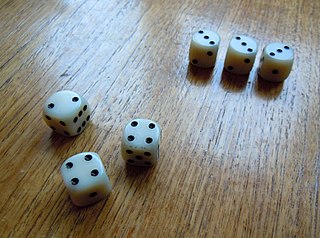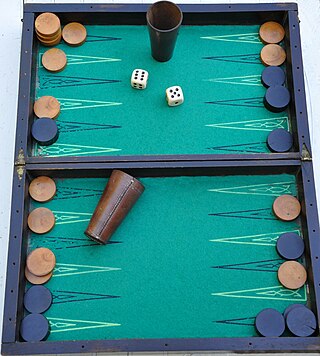
Backgammon is a two-player board game played with counters and dice on tables boards. It is the most widespread Western member of the large family of tables games, whose ancestors date back nearly 5,000 years to the regions of Mesopotamia and Persia. The earliest record of backgammon itself dates to 17th-century England, being descended from the 16th-century game of Irish.

Craps is a dice game in which players bet on the outcomes of the roll of a pair of dice. Players can wager money against each other or against a bank. Because it requires little equipment, "street craps" can be played in informal settings. While shooting craps, players may use slang terminology to place bets and actions.

Ludo is a strategy board game for two to four players, in which the players race their four tokens from start to finish according to the rolls of a single die. Like other cross and circle games, Ludo is derived from the Indian game Pachisi. The game and its variations are popular in many countries and under various names.

Parcheesi is a brand-name American adaptation of the Indian cross and circle board game Pachisi, published by Selchow & Righter and Winning Moves Games USA.

Mia is a simple dice game with a strong emphasis on bluffing and detecting bluff related to Liar's dice.

Nard is an historical Persian tables game for two players that is sometimes considered ancestral to backgammon. It is still played today, albeit in a different form. As in other tables games, the playing pieces are moved around a board according to rolls of dice. It uses a standard tables board, but has a different opening layout and rules of play from that of backgammon.

Beer die, beer dye or snappa is a table-based drinking game in which opposing players sit or stand at opposite ends and throw a die over a certain height with the goal of either landing the die in their opponent's cup or having the die hit the table and bounce over the scoring area to the floor. The defending team attempts to catch the die one-handed after it hits the table, but before it touches a non-table surface. The game typically consists of two two-player teams with each of the four players having a designated cup on the table, but can also be played one-vs-one.

Cee-lo is a gambling game played with three six-sided dice. There is not one standard set of rules, but there are some constants that hold true to all sets of rules. The name comes from the Chinese Sì-Wŭ-Liù (四五六), meaning "four-five-six". In America it is also called "See-Low," "Four-Five-Six," "The Three Dice Game," "Roll-off!," and by several alternative spellings, as well as simply "Dice." In China it is also called "Sān Liù Bàozi" (三六豹子), or "Three-Six Leopards". In Japan, it is known as "Chinchiro" (チンチロ) or "Chinchirorin" (チンチロリン).

Acey-deucey is a tables game, a family of board games that includes backgammon. Since World War I, it has been a favorite game of the United States Navy, Marine Corps, and Merchant Marine. Some evidence shows that it was played in the early 1900s aboard U.S. Navy ships. The game is believed to be rooted in the Middle East, Greece, or Turkey, where there were variants in which the game started with pieces off the board.

High Rollers is an American television game show that involved contestants trying to win prizes by rolling dice. The format was based on the dice game shut the box.
Dice chess can refer to a number of chess variants in which dice are used to alter gameplay; specifically that the moves available to each player are determined by rolling a pair of ordinary six-sided dice. There are many different variations of this form of dice chess. One of them is described here.

Dice 10,000 also Greed, Dix Mille, Reload, 5-Dice is the name of a family dice game played with 6 dice; it is similar or identical to the commercialized Farkle. It also goes by other names, including Cargoose, Zilch, Zilchers, Foo, Boxcar, Bogus, Lewis' Dice, Crap Out.

Gul bara is a tables game, an ancient genre of board games that includes Backgammon, Trictrac and Nard. It is also called Rosespring Backgammon or Crazy Narde. The aim of the game is to move all of one's men around the board and bear them off. The first player who bears off all his or her men wins. The game is popular in Bulgaria, Azerbaijan, Greece, Turkey and North Macedonia.
Kinito is a drinking game involving people, two dice, a table, a cup or basket, and beer or sangria or kalimotxo. Originally from Spain, this game evolves from Kiriki into a more social game. The object of the game is to force either the person preceding you or the person following you to drink.
Mexico is an elimination-style dice game, in which several players agree to play a set number of rounds. After each round, one player is eliminated. When all players but one have been eliminated, the remaining player wins the game. Owing to its extremely simple play-structure, it is generally pursued as a method of gambling, whereby the final remaining player wins the amount of money wagered by each person who was eliminated in earlier rounds. A variant of the drinking game liar's dice known as Mexican or Mia uses similar dice rolls, but has very different game mechanics.
Chingona is a dice game played by two or more players, using four or five dice and a cup. It is usually played to decide who is to pay for the next round of drinks, but betting can also be involved.

Ship, Captain, and Crew is a drinking game played with five dice. The game can be played with as few as two people, but is usually played in a group of five or more. The object of the game is to roll a six, a five ("captain"), and a four ("crew") with three dice, and get the highest score with the other two dice. In other versions, a four is the "mate" and the remaining dice are the crew.

Biscuit is a drinking game played with two dice.

Sevens, elevens, and doubles is a drinking game played with two dice. The game can be played with as few as two people, but is usually played in a group of five or more. The object of the games is to roll a 7, 11 or any double. To win the game: remain the last drinker.

The following is a glossary of terms used in tables games, essentially games played on a Backgammon-type board. Terms in this glossary should not be game-specific, but applicable to a range of tables games.

















